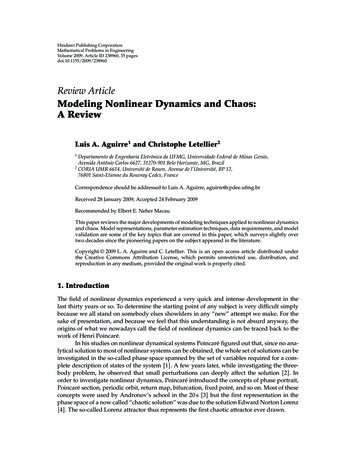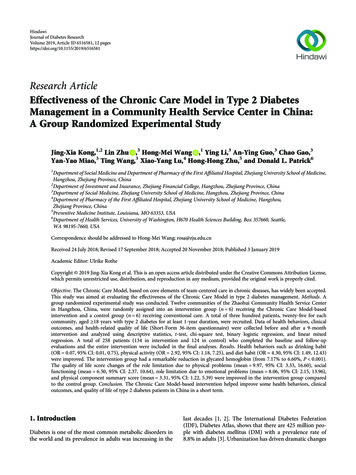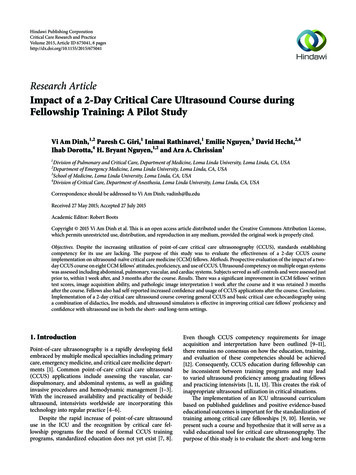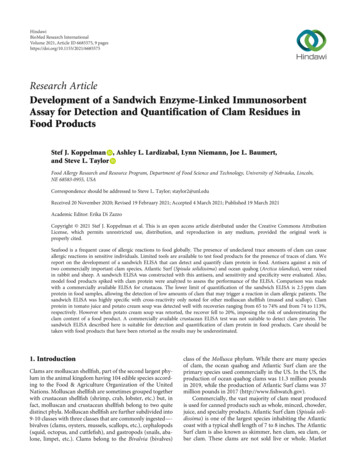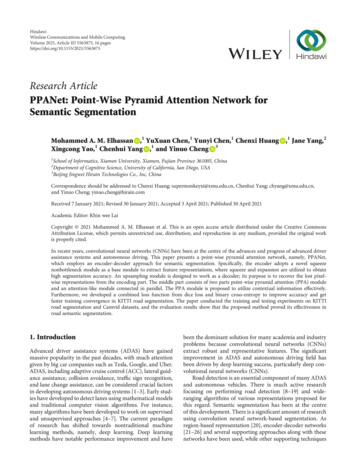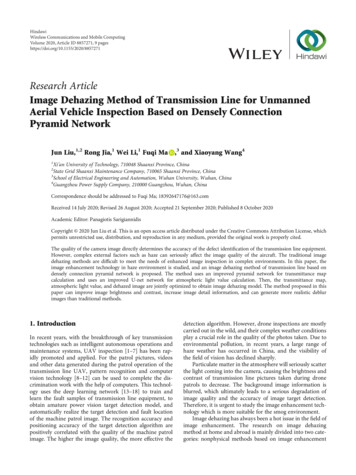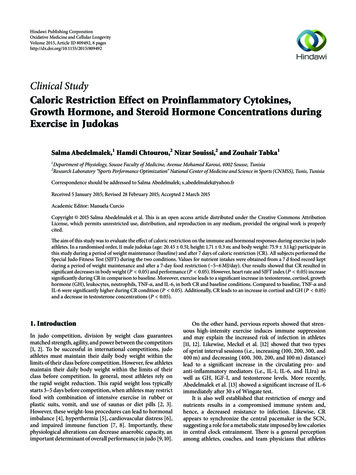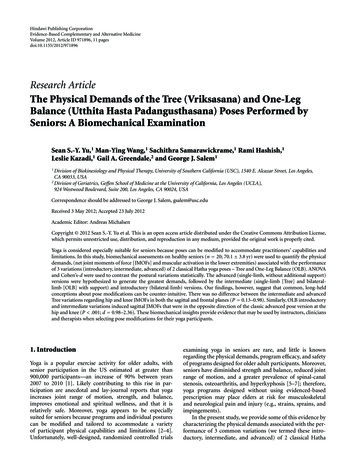
Transcription
HindawiJournal of Diabetes ResearchVolume 2020, Article ID 5728674, 13 pageshttps://doi.org/10.1155/2020/5728674Review ArticleRecent Developments in Diabetic Retinal Neurodegeneration: ALiterature ReviewShani Pillar ,1,2 Elad Moisseiev,1,2 Jelizaveta Sokolovska,3 and Andrzej Grzybowski4,51Department of Ophthalmology, Meir Medical Center, Kfar Saba, IsraelSackler School of Medicine, Tel Aviv University, Tel Aviv, Israel3Faculty of Medicine, University of Latvia, Riga, Latvia4Department of Ophthalmology, University of Warmia and Mazury, Olsztyn, Poland5Institute for Research in Ophthalmology, Foundation for Ophthalmology Development, Poznan, Poland2Correspondence should be addressed to Shani Pillar; shanigo@gmail.comReceived 3 July 2020; Revised 11 October 2020; Accepted 24 November 2020; Published 7 December 2020Academic Editor: Carla IacobiniCopyright 2020 Shani Pillar et al. This is an open access article distributed under the Creative Commons Attribution License,which permits unrestricted use, distribution, and reproduction in any medium, provided the original work is properly cited.Neurodegeneration plays a significant role in the complex pathology of diabetic retinopathy. Evidence suggests the onset ofneurodegeneration occurs early on in the disease, and so a greater understanding of the process is essential for prompt detectionand targeted therapies. Neurodegeneration is a common pathway of assorted processes, including activation of inflammatorypathways, reduction of neuroprotective factors, DNA damage, and apoptosis. Oxidative stress and formation of advancedglycation end products amplify these processes and are elevated in the setting of hyperglycemia, hyperlipidemia, and glucosevariability. These key pathophysiologic mechanisms are discussed, as well as diagnostic modalities and novel therapeuticavenues, with an emphasis on recent discoveries. The aim of this article is to highlight the crucial role of neurodegeneration indiabetic retinopathy and to review the molecular basis for this neuronal dysfunction, its diagnostic features, and the progresscurrently made in relevant therapeutic interventions.1. IntroductionDiabetic retinopathy is a major cause of preventable visionimpairment and blindness worldwide, with increasingprevalence during recent decades [1, 2]. Traditionally, vasculopathy has been considered the primary pathophysiologicmechanism responsible for diabetic retinopathy (DR).However, in recent years, the role of diabetic retinal neurodegeneration (DRN) is increasingly evident and quite possiblysupersedes that of vasculopathy as the primary pathogenicevent of the disease. Indeed, it has been suggested thatDRN is not only a possible biomarker for early developmentof the vasculopathy that constitutes DR but rather that DRNis in fact a causal factor in the development of DR [3–7]. Theterm diabetic retinal disease (DRD) is used to integrate theretinal microvasculopathy and retinal neuropathy caused bydiabetes [8]. As current focus of medical practice, in termsof early detection and treatment of DRD, lies on the vascularcomponent of DR, new discoveries regarding DRN’s signifi-cance may lead to a paradigm shift. In this review, we aimto provide a comprehensive and up-to-date overview of therapidly expanding body of work elucidating DRN’s role inDRD and its effect on diagnostics and treatment.2. MethodsThe PubMed and Medline databases were the main resourcesused to conduct the medical literature search. An extensivesearch was conducted to identify relevant articles concerningDRN published up to March 31, 2020. Emphasis was placedon recent articles, published since January 1, 2018, but earlierarticles were also included if they provided significant information to the understanding of DRN. The following keywords were used in various combinations: diabetic retinalneurodegeneration, neurodegenerative, neurodegeneration,neuroprotective, diabetes, diabetic retinopathy, diabetic retinal disease, diabetic macular edema, and diabetic eye disease.We included original studies and reviews that described
2incidence, pathogenesis, imaging, and therapies of retinalneurodegeneration in diabetes. Case reports were excluded.Of the studies retrieved by this method, we reviewed allpublications in English and those having English abstracts.Other articles cited in the reference lists of identified publications were considered as a potential source of information.No attempts were made to discover unpublished data.3. DRN Pathophysiology3.1. DRN Basic Pathophysiology. Dysfunction of the retinal“neurovascular unit” (NVU) is key in the development ofDRN. The term NVU refers to the intricate physical andfunctional relationship between neurons, glia, and vasculature in the central nervous system. In the retina, it formsthe blood-retinal barrier (BRB) and maintains energyhomeostasis and neurotransmitter regulation [9, 10]. Theretinal NVU is damaged early in the progression of diabetes,as a result of processes of innate immunity, the complementsystem, and microglia activated by the disease [11]. Suchdamage is expressed by reduced functional reactivity, whichmay be detected prior to clinical appearance of DR changes[12–14]. Subsequent impairment in the NVUs leads tobreakdown of the BRB and vascular leakage, with manifestretinopathy [9, 15]. The breakdown of the BRB is the culmination of processes governed by the secretion of many factors, among which are vascular endothelial growth factor(VEGF), proinflammatory cytokines (e.g., IL-1β, TNF-α,IL-6, and monocyte chemoattractant protein-1 (MCP-1)),and components of complement. These are variouslysecreted from RPE, glia, and immune cells [15]. In the latestages of DR, immune privilege is compromised, and the retina is infiltrated by circulating immune cells and serumproteins, further damaging blood vessels and neurons. Furthermore, even after the BRB is repaired, the blood-derivedimmune stimulators and responders may remain in theneuronal retina [16].The impairment of the neurosensory retina in diabetes isgoverned by various mechanisms, which may be classified asinflammatory, metabolic, and genetic/epigenetic. Principalcomponents include imbalance of neurotrophic factors, oxidative stress, and glial reactivity [17, 18]. The latter pertainsto the activation and proliferation of astrocytes, Müller cells,and microglia in the diabetic retina, causing secretion of proinflammatory mediators and neurotoxic factors, with subsequent reactive gliosis, diminished retinal neuronal function,and neural-cell apoptosis [19–22]. Early-on in diabetes,changes in astrocytes are observed, such as a decrease in cellnumber and altered protein expression profile, coincide withinner retinal hypoxia and functional deficits in ganglion cellresponses [23]. Müller cells’ dysfunction due to chronichyperglycemia causes them to release a large variety ofgrowth factors and cytokines. This affects vascular dysfunction and angiogenesis but also serves to protect glia cellsand retinal neurons [24]. Reactive Müller cells are thoughtto be initially neuroprotective but consequently may contribute to neuronal degeneration. This is owing to variousdysfunctional Müller cell faculties, such as malfunction ofglutamate uptake, and expression of nucleoside triphosphateJournal of Diabetes Researchdiphosphohydrolase 1 (NTPDase1), enabling extracellularadenosine formation [25]. Microglia, the retinal macrophages, are activated in diabetes due to a complex interplaybetween hyperglycemia, oxidative stress, leukostasis, and vascular leakage. In turn, microglia increase proliferation andmigration and demonstrate transcriptional changes, causingrelease of various proinflammatory mediators, including cytokines, chemokines, caspases, and glutamate. This results inapoptosis of retinal neurons, consequential thinning of thenerve fiber layer, and eventual visual loss [26–29]. Multifocalelectroretinogram (mfERG) is most commonly used in studiesto unveil the functional ramifications of DRN, even in patientswith no DR or mild nonproliferative DR (NPDR) [30–33].3.2. Recent Findings in DRN Pathophysiology. Galectin-3 regulates several biological processes, including ones involved ininflammation, oxidative stress, and apoptosis. It has beenlinked to diabetes’ development and identified as a biomarkerfor prediabetes and diabetes [34, 35]. In streptozotocin(STZ-) induced diabetic mice, galectin-3 knockout correlatedwith less macrophage infiltration/proliferation and less activation of astrocytes and microglia in the optic nerve, as wellas less retinal ganglion cell (RGC) death and a higher numberof myelinated nerve fibers [36]. These findings indicategalectin-3’s involvement in stimulation of neuroinflammation and neurodegeneration in the diabetic retina [18].Serine racemase (SRR) and its product, D-serine, areknown to contribute to neurotoxicity, through serine’s activity as an endogenous coagonist of the N-methyl-D-aspartatereceptor (NMDA-R), a mediator of glutamate excitotoxicity.Previous studies show that increased retinal levels of SRR andD-serine are correlated with DRD [37, 38]. Recently, this linkhas been further substantiated owing to studies demonstrating an attenuation of retinal neurodegeneration in diabeticmice with SRR deletion or loss-of-function mutation [39, 40].The stress response protein regulated in developmentand DNA damage-response 1 (REDD1), known to promoteneuronal apoptosis, was previously demonstrated to be overexpressed in response to hyperglycemia in the retina of diabetic rodents [41]. A recent study elucidated the protein’simportance in neurodegeneration. It was found that celldeath occurred concomitantly with REDD1 overexpressionin hyperglycemic conditions in retinal cell cultures, whereasREDD1-deficient cells were not driven to cell death by hyperglycemia. Similar results were exhibited in diabetic micemodels, where retinal cell apoptosis, as well as functionaldeficiencies in visual acuity and contrast sensitivity, wereavoided in REDD1-deficient diabetic mice [42].The microtubule-associated protein tau is a critical mediator of neurotoxicity in neurodegenerative diseases, such asAlzheimer’s disease (AD), but has not been previously studied in association with DRN. In a study of high-fat diet(HFD-) induced diabetes mice models, hyperphosphorylatedtau was found to cause vision deficits and synapse loss ofRGCs and eventually retinal microvasculopathy and RGCsapoptosis [43].Several neuroprotective factors were recently establishedto be associated with DRN: diabetic mice models were foundto have reduced levels of αA-crystallin (molecular chaperone,
Journal of Diabetes Researchregulating neuronal cell survival in multiple neurodegenerative conditions) [44], SIRT6 (a NAD-dependent sirtuin deacylase, known to modulates aging, energy metabolism, andneurodegeneration) [45], thioredoxin (antioxidant involvedin antiapoptosis and transcriptional regulation) [46, 47],and ciliary neurotrophic factor (CNTF) [48]. Of note, CNTFis known to enhance survival of photoreceptors and RGCsand has broad neuroprotective effects on damaged retinas.Another known neuroprotectant, X-box binding protein 1(XBP1), was recently studied using a conditional retinaspecific knockout mouse line. The study demonstrated thatdepletion of XBP1 in retinal neurons results in early onsetretinal function decline, loss of RGCs and photoreceptors,disrupted photoreceptor ribbon synapses, and Müller cellactivation after induction of diabetes [49]. Interestingly, bothXBP1 and αA-crystallin are involved in the regulation of theunfolded protein response or endoplasmic reticulum stressresponse, in which they play key roles to prevent proteinaggregation and subsequent cell toxicity and cell death.Recent findings regarding the dysregulation of the Larginine pathway in plasma samples from type 2 diabeticpatients with PDR [50, 51] may lead to novel therapeuticavenues using substances such as arginase 1 for treatmentof DRN and other ischemic retinopathies [52].One factor which stands out in its increasingly recognized importance to neurodegenerative processes is Sigma1receptor (Sig1R) [53–58]. It is a pluripotent modulator witha number of biological functions, many of which are relevantto retinal disease, including involvement in calcium regulation, modulation of oxidative stress, ion channel regulation,and molecular chaperone activity. Several compelling studieshave provided evidence of powerful in vivo neuroprotectiveeffects against ganglion cell loss as well as photoreceptor cellloss [59]. The connection to diabetes was first demonstratedin a study published at 2012, revealing that the damagecaused to retinal ganglion cells in mice lacking Sig1R wasaccelerated by STZ-induced diabetes [60].It is known that hyperglycemia and HbA1c levels over 7%are major factors predisposing patients with diabetes to vascular complications [61]. Furthermore, recent data indicatesthat increased glucose variability might contribute to progression of diabetic complications even if HbA1c is in thetarget range. Importantly, glucose variability, as assessed bycontinuous glucose monitoring, has been associated withdamage to the neuroretina, independently of HbA1c levels,in patients with type 1 diabetes [62, 63]. Of recent, the mechanism by which glucose variability promotes neuroretinaldegeneration was shown to involve activation of Müller cells.In a study of rat retinal Müller cells, the impact of glucosevariability was analyzed. Cell activation was shown to differaccording to basal glucose conditions, as well as subsequentexposure (constant high glucose versus alternating low/highglucose) [64].4. Recent Developments in DRN ImagingRetinal neuronal apoptosis occurs early in the disease course,causing a reduction in the thickness of inner retinal layersand of the retinal nerve fiber layer (RNFL), as may be3depicted on optical coherence tomography (OCT) [6, 65–67]. In the Maastricht Study, reduced thickness of thepericentral macula was found in as early as prediabetesconditions, when compared to that of people with normalglucose metabolism, and a significant linear trend was established correlating macular thinning with severity of glucosemetabolism status [68]. The conclusion that retinal neurodegenerative processes commence prior to initiation of diabeteswas later supported by a study demonstrating thinner innerretinal layers and photoreceptor layers in patients with metabolic syndrome [69]. This may suggest that factors such asinsulin resistance and adipose tissue-derived inflammationcould cause neurodegenerative effects, independently fromhyperglycemia.Diabetes duration was found to be negatively related tothe RNFL thickness in type 2 diabetic patients with earlystage DR, as were BMI, triglycerides, HDL, HbA1c, andalbumin-creatinine ratio [70]. Longitudinal studies of type1 and type 2 diabetes patients with no DR or mild NPDRrevealed progressive thinning of inner retinal layers [71–74]. A study using Cirrus-HD OCT for grading of en face slabOCT images of the innermost retina showed progression ofdamage over time and with advancing stage of DR [73].Kim et al. also found baseline macular ganglion cell–innerplexiform layer (mGCIPL) thickness and mGCIPL thinningrate to be independent risk factors of DR progression [71].The retinal structural alterations described have clinicalimplications in terms of functional deficiencies such asdecreased hue discrimination, contrast sensitivity, delayeddark adaptation, and abnormal visual fields [75, 76]. Such correspondence to visual impairment was recently exemplifiedusing an Optos OCT/SLO/microperimeter, which displayeda correlation between reduced inner and total macular thickness, and reduced microperimetric sensitivity [77].OCT angiography (OCTA) has been extensively studiedin DR, but until recently, no attempts have been made touse this technology to help elucidate the crosslink betweenneurodegeneration and vascular changes. Hafner et al. founda significant association between the vessel density in thedeep capillary plexus of the parafovea on OCTA and theinner retinal layer thickness, mainly ganglion cell layer(GCL) and RNFL [78]. These results indicate that retinalneurodegenerative features are associated with retinal microvascular perfusion. A controlled study of eyes with no DR ormild NPDR discovered a strong positive correlation betweenloss of mGCIPL and reduction in vessel density from baselineto 24 months. Multivariable regression analysis showed thatthinner baseline mGCIPL and greater reduction in mGCIPLthickness were significantly associated with change of vesseldensity [74].5. Neuroprotective Therapeutic AvenuesCurrently, managing DRD involves stressing the necessity ofbalancing blood glucose levels and targeting the microvasculopathy that is at the core of DR. Prevention and treatment ofthe neurodegenerative component of DRD is tragically overlooked, though the insidious loss of neurons is irreversible.The ever-growing research in the field of DRN presents
4opportunities to incorporate neuroprotective strategies asadjunct therapies with existing treatments for DR. Potentialtreatments tend to focus on one of the key players in DRN:neurotrophic factors, inflammation, and oxidative stress,though some putative therapies display mixed mechanisms.Many neuroprotective therapeutic avenues are continuouslybeing investigated in the context of retinal disease, as hasbeen the subject of several reviews [5, 79–84]. Our aim is toshine a light on the most recent studies of therapeutics atthe forefront of the battle against DRN (Table 1).5.1. Anti-inflammatory Substances. Alpha-1-antitrypsin(A1AT) commonly works as an inhibitor of serine proteases.In the context of DRD, it has been described as anti-inflammatory, involved in apoptosis avoidance and extracellularmatrix remodeling and also in the protection of vessel wallsand capillaries [85]. STZ-induced diabetic mice were systemically treated with A1AT (8 weekly intraperitoneal injections)and displayed a markedly reduced inflammatory status. Thiswas evident by the downregulation of NFκB, iNOS, andTNF-α expression, all normally increased in diabetic modelsand related inflammation. The treatment caused a decreasein both retinal thinning and loss of ganglion cells, thusameliorating neurodegenerative changes [86]. In an attemptto elucidate A1AT’s mechanism of action on a molecularlevel, it was later studied in ARPE-19 cells exposed to highglucose. A1AT normalized the levels of NFκB and its targetsiNOS and TNF-α, as well as regulated proteins related toglucose metabolism, awakened signals related to epithelialmesenchymal transition, and normalized protein levelsinvolved in essential RPE function [87].Citicoline is an endogenous compound known to act as aneuroprotective agent and has been shown to be effective inthe treatment of glaucoma [88]. Topical administration ofciticoline in liposomal formulation in the db/db mousemodel (a model for obesity-induced type 2 diabetes) prevented glial activation and neural apoptosis in the diabeticretina. In vivo, citicoline was able to ameliorate the functionalabnormalities recorded on ERG in the diabetic mice. Themain mechanism implicated was the inhibition of the downregulation of synaptophysin induced by diabetes and theprevention of upregulation of NFκB and TNF-α [89].In a retrospective study of patients with diabetic macularedema treated with intravitreal fluocinolone acetonide, neuroretinal analysis of OCT was obtained at 3-month intervalsbefore and after treatment. In the region located 1.5 mm to3.0 mm from the fovea, there was a statistically significantdecrease in the posttreatment rate of DRN (defined as changeover time of the inner neuroretinal thickness), comparedwith the pretreatment rate [90]. Prospective, controlled trialsare necessary to further validate this effect.5.2. Antioxidants. A PPARα agonist used to treat dyslipidemia, fenofibrate, was found by major studies to haveunprecedented therapeutic effects in DR [91–93], thoughthe mechanism for this has not been previously elucidated(and could conceivably be caused by its lipid-normalizingeffect). A later study of an experimental mouse model of type2 diabetes indicated that neuroprotection is one of the under-Journal of Diabetes Researchlying mechanisms by which fenofibrate exerts its beneficialactions in DRD [94]. Recently, in a rat model of type 1 diabetes, activation of PPARα decreased retinal cell death and hada robust protective effect on retinal function. The studyrevealed a neuroprotective effect of PPARα throughimproved mitochondrial function and subsequent alleviationof energetic deficits, oxidative stress, and mitochondriallymediated apoptosis [95]. As such, PPARα is a promisingdrug target, and since then, new classes of PPARα agonistswere studied for proof-of-concept in vivo efficacy and preliminary pharmacokinetic assessment [96].As previously mentioned, hyperphosphorylated tau wasfound to participate in DRN in a study of diabetic mice. Thishyperphosphorylation, known to be induced by oxidativestress, was shown to result from an activation of glycogensynthase kinase 3β (GSK3β). Therapeutically, intravitrealadministration of an short interfering RNA (siRNA) targeting tau or a specific inhibitor of GSK3β attenuated tau hyperphosphorylation and caused a reversion of RGC-synapse lossand restoration of visual function [43]. In a separate study,topical ocular application of ginsenoside Rg1 was shown toalleviate tau hyperphosphorylation and consequent synapticneurodegeneration of RGCs in diabetic mice [97]. Notoginsenoside R1 was also found to have numerous mitigatingeffects in DRD, as oral treatment to diabetic mice causeddramatic alleviation of retinal vascular degeneration, ofreduced retinal thickness, and of impaired retinal function[98]. Ginsenoside Rg1 and notoginsenoside R1 are two ofthe saponins extracted from the traditional Chinese medicalherb Panax notoginseng. They are known to possessantioxidant and anti-inflammatory qualities, with resultingantidiabetic effects, also studied in the context of diabeticretinopathy [99, 100].Extensive literature is available regarding Spermine oxidase (SMOX), a mediator of polyamine oxidation, and itsrole in neurodegenerative diseases in general and in neuroretinal damage specifically. SMOX inhibitors have been foundto limit oxidative stress and reduce retinal neurodegenerationfrom various etiologies [101]. Recently, STZ-induced diabeticmice were systemically treated with MDL 72527-a SMOXinhibitor. Compared with placebo-treated diabetic mice, thetreated mice displayed significantly improved ERGresponses, inhibition of retinal thinning, and attenuation onRGC damage and of neurodegeneration [102].Similarly, several other substances have been investigatedfor their antioxidative effect in DRN. Diabetic mice treatedintravitreally with caffeic acid alkyl amide derivatives(CAF6 or CAF12), intraperitoneally with the amino acidtaurine, or orally with the leucine analogue gabapentin, theacrolein-scavenging drug, 2-HDP, or the pigment astaxanthin, all exhibited reduction of oxidative stress and ofneurodegenerative damage [103–107].5.3. Neurotrophins and Other Neuroprotective Factors.Somatostatin (SST) is an endogenous neuroprotectivepeptide that is downregulated in the diabetic retina. SSTdownregulation is related to glial activation and neuron apoptosis, the two hallmarks of retinal neurodegeneration [108].SST was one of the first reported topical experimental drugs
Journal of Diabetes Research5Table 1: Novel therapeutic approaches to diabetic retinal neurodegeneration in experimental ypsinCiticolineFluocinolone acetonideAntioxidantsFenofibrate and other PPARαagonistsInhibitors of protein tauhyperphosphorylation: ginsenosideRg1 Notoginsenoside R1 siRNASpermine oxidase inhibitorsCaffeic acid alkyl amide derivativesTaurineGabapentinAcrolein-scavenging 2-HDPNeurotrophins and otherneuroprotective factorsMixed or unknownmechanismsSomatostatinFlavonoids and othernutraceuticalsCiliary neurotrophic factorAngiotensin II type 1receptor blockersSigma1 receptorAngiotensin-convertingenzyme 2 activatorsSynthetic microneurotrophinGLP-1 receptor agonistsBNN27Brain-derived neurotrophic factorLamivudineEicosapentaenoic acid ethyl ester Endothelin-1 receptor antagonistsIntravitreal bone marrowIntraocular pressure-loweringCD133 stem cells transplantationagentsAstaxanthinto exert a neuroprotective effect [108]. In a randomized, placebo-controlled, phases II–III trial by the EUROCONDORconsortium, topical administration of SST and brimonidinewas useful in arresting the progression of neurodegenerationin early DR with preexisting retinal neuro-dysfunction [109].Amato et al. used the SST analog octreotide bound tomagnetic nanoparticles and revealed it may be used as anoctreotide intraocular delivery system, ensuring localizationto the retina and enhanced bioactivity [110].Ciliary neurotrophic factor (CNTF) is a member of theIL6 family of cytokines, and it supports the differentiationand survival of neurons. CNTF is also known to enhancesurvival of retinal photoreceptors and RGCs. CNTF deliveredby encapsulated cell intraocular implants is approved fortreatment of retinitis pigmentosa and of geographic atrophy[111]. In a recent study of STZ-induced diabetic rats, intravitreal injections of CNTF rescued RGCs and dopaminergicamacrine cells from neurodegeneration [48].The accumulation of evidence regarding Sig1R’s role inretinal neurodegeneration led to studies exploring its potential as a novel treatment target. Ligands for Sig1R, such as( )-pentazocine [( )-PTZ], were found confer marked retinal neuroprotection in vivo and in vitro [59]. In murinemodels of diabetic retinopathy, administration of intraperitoneal injections of ( )-PTZ resulted in significant neuroprotection, reduced evidence of oxidative stress, and preservedretinal architecture [112, 113].The synthetic microneurotrophin BNN27 is a BBB- andBRB-permeable dehydroepiandrosterone (DHEA) derivative. It was injected intraperitoneally to STZ-induced diabeticrats and reversed the diabetes-induced glial activation andreduction of amacrine cells in a dose-dependent manner.Treatment was also found to target the inflammatory component of the disease, as it reduced proinflammatory andincreased anti-inflammatory cytokine levels [114]. Theneuroprotective effect to the diabetic retina was maintainedwith topical administration of BNN27 [115].It has long been known that levels of brain-derivedneurotrophic factor (BDNF) are reduced in DRN and thatintraocular administration of BDNF counteracts diabetesrelated neurodegenerative processes [116]. Of late, oralintake of eicosapentaenoic acid ethyl ester (EPA-E) wasshown to ameliorate BDNF reduction and improve functional results on ERG in DRD. An EPA metabolite, 18-HEPE,induced BDNF upregulation in Müller glia cells and recoveryof ERG results [117]. In a separate study, bone marrowCD133 stem cells were intravitreally transplanted intoSTZ-induced diabetic mice and caused retinal BDNF levelsto increase, with consequent retinal cell survival [118].5.4. Mixed or Unknown Mechanisms5.4.1. Nutritional Supplements and Nutraceuticals. A varietyof nutraceuticals have been studied, both in vitro andin vivo, and found to have a significant antioxidant andanti-inflammatory effect, at times reducing both the neuraland vascular damage typical of DR.Flavonoids are bioactive compounds found largely in dietary plants, aiding in the plants’ protection from ultravioletradiation, oxidants, and pathogens [119]. A high-flavonoiddiet was found to be associated with lower levels of diabeticmarkers and reduced the prevalence of DR by 30% [120],and green tea was found to be neuroprotective in DR [121].Over the years, a number of experimental studies showedthat dietary flavonoids, such as quercetin [122], rutin [123],naringenin [124], and others, cause a reduction in oxidativestress and ameliorate inflammation and apoptosis in DRN,as was recently extensively reviewed [125, 126].Nonflavonoid polyphenols, such as curcumin and resveratrol, have been shown to exert antiapoptotic effects on theretina of diabetic rat models, with attenuation of retinal thinning, among other neuroprotective influences. Both thesesubstances have been reported to inhibit apoptosis by stimulating autophagy [127–130].A variety of studies have examined the possible protective role of Müller cell-autophagy in DR [131, 132]. Inhibition of autophagy increased retinal cell apoptosis inducedby high glucose [133], whereas its activation could protect
6Müller cells from high glucose-induced apoptosis [134].Epigallocatechin-3-gallate (EGCG) is a major polyphenolin green tea that has attracted attention as a potential therapy for various pathologies, including apoptosis of retinalneurons [135, 136]. In a recent study, retinal Müller cellsin high glucose conditions treated with EGCG showed activation of autophagy machinery and reestablishment of cargodegradation, which protected the cells from apoptosis.EGCG could increase the ability of cells to proliferate byincreasing autophagy. In a mouse model of diabetic retinopathy, EGCG treatment reduced the reactive gliosis of Müllercells and decreased retinal damage [137].As mentioned previously, the antioxidative effect of notoginsenoside R1 [98] and the neurotrophic effect of EPA-A[117, 118] are also the subject of recent research, as are othernutraceuticals and nutritional supplements [138–140].5.4.2. Therapeutic Targets of the Renin-Angiotensin System(RAS) in DRN. The role of RAS in the development and progression of DRD is well established [141–144]. In recentyears, research shed more light in regard to the relationshipbetween RAS and the neurovascular unit [145]. Someresearchers explored the therapeutic feasibility of RASrelated substances for DRN prevention or control. Retinalexplants treated with angiotensin II demonstrated a 40%reduction in RGC surv
Review Article Recent Developments in Diabetic Retinal Neurodegeneration: A Literature Review Shani Pillar ,1,2 Elad Moisseiev,1,2 Jelizaveta Sokolovska,3 and Andrzej Grzybowski4,5 1Department of Ophthalmology, Meir Medical Center, Kfar Saba, Israel 2Sackler School of Medicine, Tel Aviv University, Tel Aviv, Israel 3Faculty of Medicine, University of Latvia, Riga, Latvia

